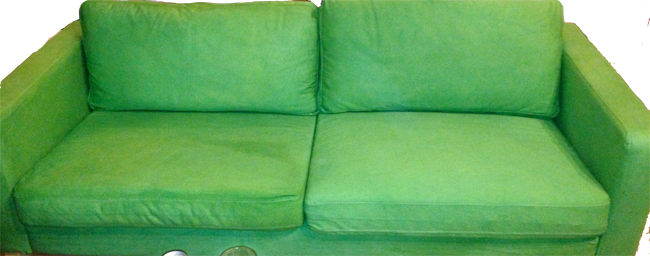What is the best way to change our sofa cover from streaky lime green to dark kilt green?
Name: Ben
Country or region: Midwest
Message: Hi there Paula,
 My girlfriend and I recently tried dyeing a set of covers for our Ikea sofa using Rit dye in the wash. It was streaky in patches, but mostly it was just the wrong color. We wanted a muted green, but got a lime green in the end. We are looking into using fiber reactive dyes this time around (it is 100% cotton), but we are curious what is the best way to change the color through re-dyeing. How would you advise we proceed to go from this couch to something more like this shade of Dharma dye:
My girlfriend and I recently tried dyeing a set of covers for our Ikea sofa using Rit dye in the wash. It was streaky in patches, but mostly it was just the wrong color. We wanted a muted green, but got a lime green in the end. We are looking into using fiber reactive dyes this time around (it is 100% cotton), but we are curious what is the best way to change the color through re-dyeing. How would you advise we proceed to go from this couch to something more like this shade of Dharma dye:Thank you so much!
Your sample of "kilt green" is dark and on the blue side, so you should be able to overdye that lime green to get it more-or-less the right color by dyeing with a navy blue dye, such as Dharma's Cobalt Blue. The cobalt blue has a slightly greenish cast, which will be perfectly fine in this situation.
The streakiness of the lime green might remain somewhat of a problem, though, unless you go for a mottled or variegated effect by using low water immersion dyeing (which happens to be the easiest of all sorts of dyeing to do; see "How to Do Low Water Immersion Dyeing"). If you are bothered by the streakiness and want to dye in a solid single color, then it would be good to try to remove some of the lime green before overdyeing the cover.
What water temperature did you use to apply the Rit dye? Hot water is best for removing dye, but you don't want to risk shrinking the covers, so I don't want to recommend a hotter temperature than you've already used.
Some of the Rit dye can be removed simply by washing it in hot water. If that is not effective enough, you could use a sulfur-based color remover, such as Rit Color Remover (it's an excellent product by the way, much better than Rit Dye). Unfortunately, Rit Color Remover, like all sulfur-based color removers, requires hot water to work. As an alternative, diluted chlorine bleach might remove enough of the color, and it should be used in room-temperature water, so it does not pose a shrinkage problem. Chlorine bleach should be used only for 100% cotton, but that's what you have, so that's fine. It is best to follow chlorine bleach with a dip in Anti-Chlor, which is a chemical that neutralizes the bleach so that it does not continue to damage the fabric. (See "What chemicals can be used to remove dye?"and "How can I neutralize the damaging effects of chlorine bleach?".)
If you succeed in removing much of the existing lime green, so that all that remains is a pale color, then you will want to use the kilt green dye, rather than the cobalt blue. Note that, as a very dark color, the kilt green requires a good amount of dye; using less dye will produce a lighter shade of green. Dharma's yield estimate indicates that you will probably need about three-quarters of an ounce of dye per pound of dry fabric.
(Please help support this web site. Thank you.)
(Please help support this web site. Thank you.)
Posted: Thursday - June 06, 2013 at 08:47 AM
Follow this blog on twitter here.
Quick Links
- All About Dyes & Dyeing Top -
- Top of this blog -
- FAQ -
- The Dye Forum -
- How to Tie Dye - How to Batik -
- Books - Toys - Plants -
- Top of this blog -
- FAQ -
- The Dye Forum -
- How to Tie Dye - How to Batik -
- Books - Toys - Plants -
More in this category:
- -
Statistics
Total entries in this blog:
Total entries in this category:
Published On: Jun 06, 2013 09:49 AM
Total entries in this category:
Published On: Jun 06, 2013 09:49 AM